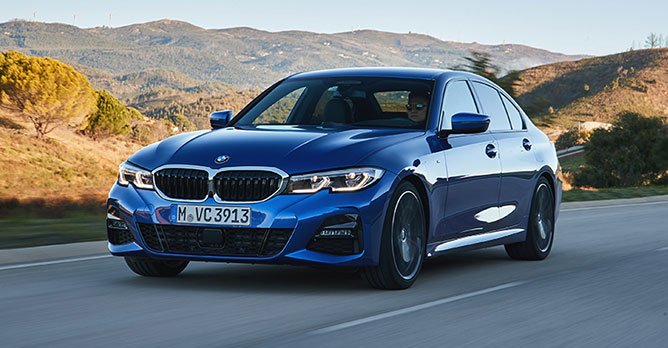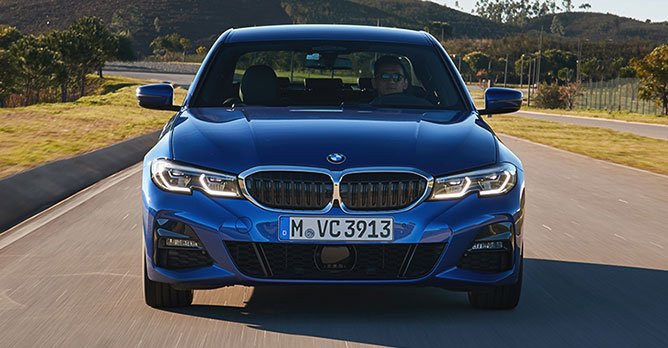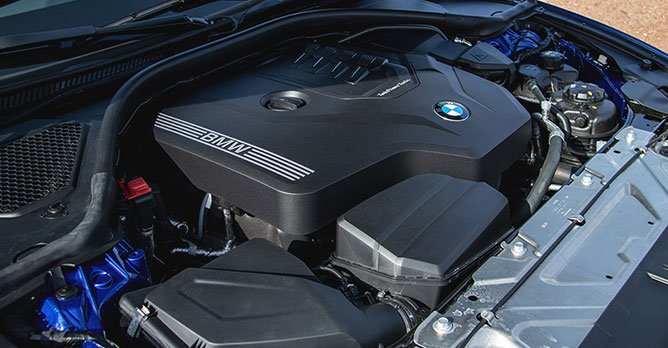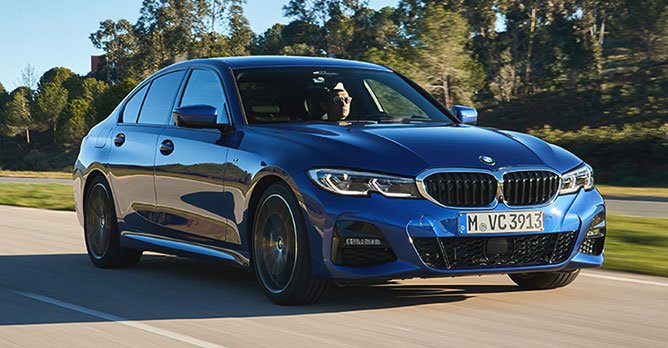BMW 3 Series Sedan 330i M Sport (A) First Drive Review
12 Dec 2018|13,893 views
What We Like
Sharper design
Improved cabin refinement
IPA feels actually usable and not just a gimmick
Best-in-class handling
Creamy smooth 2.0-litre engine
What We Dislike
Lacking in steering feel
M Sport steering wheel is too chunky for our liking
M Sport suspension can occasionally be too stiff
The BMW 3 Series has been a perpetual mainstay in the brand's model lineup, ever since the first model was launched back in 1975. Through six generations, much has changed - the design of the car has moved on significantly from the boxy early E21 model to the rounder (and much bigger) F30 model.
Of course, each successive generation also saw the car infused with new features and technologies. However, one thing that has remained constant is the involvement of the driver - for many, the 3 Series is the consummate sport sedan thanks to its best-in-class handling.
Now, the brand new seventh generation G20 3 Series is here, bringing with it an expected host of design, technological and dynamic upgrades. We headed up to Portugal to give it a spin.
A mean mug
The new 3 Series has grown notably bigger - it is 76mm longer (with a 41mm longer wheelbase), 1mm taller, and 16mm wider than its predecessor. The design language has also evolved, with a shift towards using fewer but more distinctive lines.
In this particular M Sport trim, we think the car looks quite good, with a wide and muscular front end and a sleek side profile underpinned by a cleaner, sharper design. We reckon the rear looks a little bland compared to the rest of the car, but overall it's hard to deny that the new 3 Series looks a whole lot sharper than before.
Techy savvy
The interior is pretty much the same across the new generation BMW models. That's a good thing though. It's cleaner and sleeker than before, achieved through the simplifying of surfaces and the clustering of control buttons. However, we did find the new M Sport steering wheel to be slightly too chunky for our Asian hands.
Notably, cabin refinement has been improved significantly. Our car came fitted with the optional acoustic front windows, on top of the standard acoustic windshield, which makes for a very quiet and serene cabin.
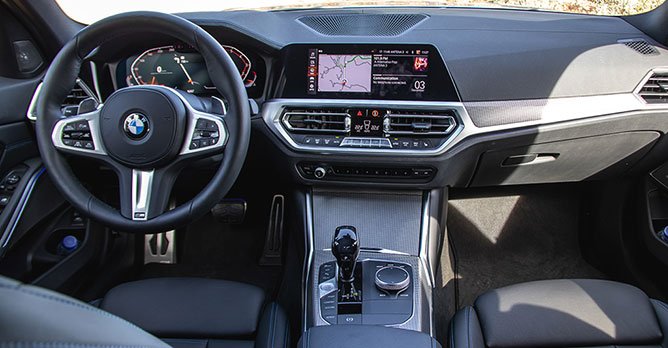
 With simplified surfaces and fewer lines, the new generation BMW cabin is sleeker and mroe focused than before
With simplified surfaces and fewer lines, the new generation BMW cabin is sleeker and mroe focused than before
The boot space remains the same at 420 litres, but the car's increased dimensions allow the boot to be reconfigured to offer more usable space in the primary loading compartment.
The car is loaded with the latest technology, and the one that will likely see the most use is the Intelligent Personal Assistant (IPA). Essentially, it allows you 'talk' to the car (though you shouldn't expect to be able to hold an entire conversation). After activating it by saying 'Hey BMW', you can then proceed to do a range of things - anything from adjusting the air-con, checking your remaining range or even locating the nearest Starbucks.
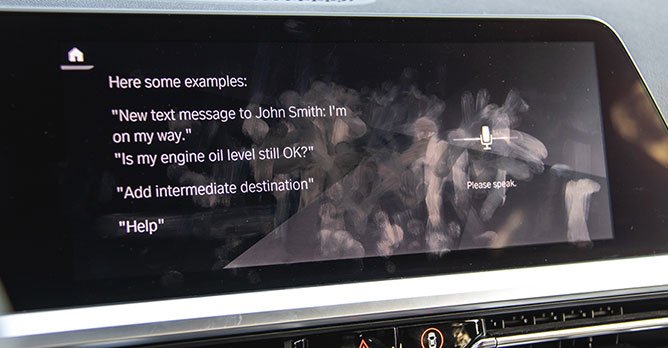
 The IPA offers you access to a host of the car's functions, with more available in the future courtesy of system updates
The IPA offers you access to a host of the car's functions, with more available in the future courtesy of system updates
One thing we did discover is that the IPA actually detects commands from the front passenger side as well. While seated in the passenger seat, we asked the car to adjust the air-con and it actually adjusts just the passenger side air-con. Pretty cool. Additionally, we found that the IPA reacts well, even managing to pick up our voice commands when the music was turned up pretty loud (and mind you, we had Iron Maiden blasting over the Harmon Kardon speakers).
Of course, the car comes loaded with the latest in driver assistance systems. The newest one is the Reversing Assistant, sort of like the rewind buton you'd find in games. If you find yourself stuck in a tight spot or dead-end road, the car is able to autonomously 'undo' the last 50m, following the exact same line you had driven. All you have to do is operate the brakes.
Of course, each successive generation also saw the car infused with new features and technologies. However, one thing that has remained constant is the involvement of the driver - for many, the 3 Series is the consummate sport sedan thanks to its best-in-class handling.
Now, the brand new seventh generation G20 3 Series is here, bringing with it an expected host of design, technological and dynamic upgrades. We headed up to Portugal to give it a spin.
A mean mug
The new 3 Series has grown notably bigger - it is 76mm longer (with a 41mm longer wheelbase), 1mm taller, and 16mm wider than its predecessor. The design language has also evolved, with a shift towards using fewer but more distinctive lines.
In this particular M Sport trim, we think the car looks quite good, with a wide and muscular front end and a sleek side profile underpinned by a cleaner, sharper design. We reckon the rear looks a little bland compared to the rest of the car, but overall it's hard to deny that the new 3 Series looks a whole lot sharper than before.
Techy savvy
The interior is pretty much the same across the new generation BMW models. That's a good thing though. It's cleaner and sleeker than before, achieved through the simplifying of surfaces and the clustering of control buttons. However, we did find the new M Sport steering wheel to be slightly too chunky for our Asian hands.
Notably, cabin refinement has been improved significantly. Our car came fitted with the optional acoustic front windows, on top of the standard acoustic windshield, which makes for a very quiet and serene cabin.

The boot space remains the same at 420 litres, but the car's increased dimensions allow the boot to be reconfigured to offer more usable space in the primary loading compartment.
The car is loaded with the latest technology, and the one that will likely see the most use is the Intelligent Personal Assistant (IPA). Essentially, it allows you 'talk' to the car (though you shouldn't expect to be able to hold an entire conversation). After activating it by saying 'Hey BMW', you can then proceed to do a range of things - anything from adjusting the air-con, checking your remaining range or even locating the nearest Starbucks.

One thing we did discover is that the IPA actually detects commands from the front passenger side as well. While seated in the passenger seat, we asked the car to adjust the air-con and it actually adjusts just the passenger side air-con. Pretty cool. Additionally, we found that the IPA reacts well, even managing to pick up our voice commands when the music was turned up pretty loud (and mind you, we had Iron Maiden blasting over the Harmon Kardon speakers).
Of course, the car comes loaded with the latest in driver assistance systems. The newest one is the Reversing Assistant, sort of like the rewind buton you'd find in games. If you find yourself stuck in a tight spot or dead-end road, the car is able to autonomously 'undo' the last 50m, following the exact same line you had driven. All you have to do is operate the brakes.
Master of its domain
One key question remains - how does it drive? The sportiness you expect from a 3 series is certainly there, and it has been turned up even more. There's plenty of bite from the steering wheel, the car corners with verve and great composure, and the engine revs out in creamy smooth manner, accompanied by a sonorous soundtrack.
Overall body rigidity has been increased by 25%, and on windy roads it certainly shows. The tauter chassis means that turn in is more direct and precise, and the car feels incredibly stable and tight through bends. The new 3 Series is an undoubtedly engaging car to drive, easily bettering the Audi A4 and the Mercedes-Benz C-Class in terms of dynamic ability. The only real complain we have is that the steering could do with more feel.
With 255bhp and 400Nm of torque available from the turbocharged 2.0-litre in-line four engine, the 330i accelerates with ease, revving energetically to 6,500rpm. Get onto the highway and the car pulls easily to 200km/h.
Our car, in M Sport trim, comes equipped with the M Sport suspension. It's great for when you want to drive hard, but it does slightly compromise ride comfort and the car's overall malleability when driven quietly. We reckon the standard suspension would be the ideal choice for most drivers, though if you want the best of both worlds, the Adaptive M suspension is always available as an option.
If you do buy the new 3 Series, one thing you will have to get used to is its added size. BMW tells us at the car actually sheds 55kg, but it sure doesn't feel that way. With the longer wheelbase and wider tracks, the car feels heftier overall, trading away some fleet-footed playfulness for added refinement and composure.
The next step
The new 3 Series feels like a very substantial car. It's not just the size, somewhat inevitable given that every car grows over its various generations. Everything about the car feels very thoroughly designed and executed. It takes an expected step forward, bursting with new technology and a sharper design.
None of that is really that surprising, really. BMW has taken a tried and tested formula and refined it further, taking a good car and making it better. It closes the gap between itself and the 5 Series, and these improvements come with no change in retail price (at least in European markets), so that's sure to delight customers. After all, you're getting more car for the same money, how do you complain?
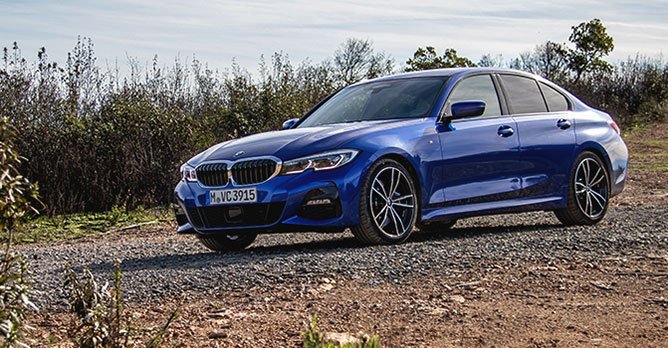
 Fans of the BMW 3 Series will find lots to love (and very little to dislike) about the new G20 model
Fans of the BMW 3 Series will find lots to love (and very little to dislike) about the new G20 model
Here in Singapore, the new 3 Series will arrive in Q2 of 2019, and will initially be offered in 330i guise with two variants - Luxury and M Sport. The Luxury variant is expected to cost around $220,000, while the M Sport variant will be priced in the region of $230,000 to $240,000.
Interested? Why not watch our video review of the 320i in Singapore?
One key question remains - how does it drive? The sportiness you expect from a 3 series is certainly there, and it has been turned up even more. There's plenty of bite from the steering wheel, the car corners with verve and great composure, and the engine revs out in creamy smooth manner, accompanied by a sonorous soundtrack.
Overall body rigidity has been increased by 25%, and on windy roads it certainly shows. The tauter chassis means that turn in is more direct and precise, and the car feels incredibly stable and tight through bends. The new 3 Series is an undoubtedly engaging car to drive, easily bettering the Audi A4 and the Mercedes-Benz C-Class in terms of dynamic ability. The only real complain we have is that the steering could do with more feel.
With 255bhp and 400Nm of torque available from the turbocharged 2.0-litre in-line four engine, the 330i accelerates with ease, revving energetically to 6,500rpm. Get onto the highway and the car pulls easily to 200km/h.
Our car, in M Sport trim, comes equipped with the M Sport suspension. It's great for when you want to drive hard, but it does slightly compromise ride comfort and the car's overall malleability when driven quietly. We reckon the standard suspension would be the ideal choice for most drivers, though if you want the best of both worlds, the Adaptive M suspension is always available as an option.
If you do buy the new 3 Series, one thing you will have to get used to is its added size. BMW tells us at the car actually sheds 55kg, but it sure doesn't feel that way. With the longer wheelbase and wider tracks, the car feels heftier overall, trading away some fleet-footed playfulness for added refinement and composure.
The next step
The new 3 Series feels like a very substantial car. It's not just the size, somewhat inevitable given that every car grows over its various generations. Everything about the car feels very thoroughly designed and executed. It takes an expected step forward, bursting with new technology and a sharper design.
None of that is really that surprising, really. BMW has taken a tried and tested formula and refined it further, taking a good car and making it better. It closes the gap between itself and the 5 Series, and these improvements come with no change in retail price (at least in European markets), so that's sure to delight customers. After all, you're getting more car for the same money, how do you complain?

Here in Singapore, the new 3 Series will arrive in Q2 of 2019, and will initially be offered in 330i guise with two variants - Luxury and M Sport. The Luxury variant is expected to cost around $220,000, while the M Sport variant will be priced in the region of $230,000 to $240,000.
Interested? Why not watch our video review of the 320i in Singapore?
What We Like
Sharper design
Improved cabin refinement
IPA feels actually usable and not just a gimmick
Best-in-class handling
Creamy smooth 2.0-litre engine
What We Dislike
Lacking in steering feel
M Sport steering wheel is too chunky for our liking
M Sport suspension can occasionally be too stiff
The BMW 3 Series has been a perpetual mainstay in the brand's model lineup, ever since the first model was launched back in 1975. Through six generations, much has changed - the design of the car has moved on significantly from the boxy early E21 model to the rounder (and much bigger) F30 model.
Of course, each successive generation also saw the car infused with new features and technologies. However, one thing that has remained constant is the involvement of the driver - for many, the 3 Series is the consummate sport sedan thanks to its best-in-class handling.
Now, the brand new seventh generation G20 3 Series is here, bringing with it an expected host of design, technological and dynamic upgrades. We headed up to Portugal to give it a spin.
A mean mug
The new 3 Series has grown notably bigger - it is 76mm longer (with a 41mm longer wheelbase), 1mm taller, and 16mm wider than its predecessor. The design language has also evolved, with a shift towards using fewer but more distinctive lines.
In this particular M Sport trim, we think the car looks quite good, with a wide and muscular front end and a sleek side profile underpinned by a cleaner, sharper design. We reckon the rear looks a little bland compared to the rest of the car, but overall it's hard to deny that the new 3 Series looks a whole lot sharper than before.
Techy savvy
The interior is pretty much the same across the new generation BMW models. That's a good thing though. It's cleaner and sleeker than before, achieved through the simplifying of surfaces and the clustering of control buttons. However, we did find the new M Sport steering wheel to be slightly too chunky for our Asian hands.
Notably, cabin refinement has been improved significantly. Our car came fitted with the optional acoustic front windows, on top of the standard acoustic windshield, which makes for a very quiet and serene cabin.

 With simplified surfaces and fewer lines, the new generation BMW cabin is sleeker and mroe focused than beforeThe boot space remains the same at 420 litres, but the car's increased dimensions allow the boot to be reconfigured to offer more usable space in the primary loading compartment.
With simplified surfaces and fewer lines, the new generation BMW cabin is sleeker and mroe focused than beforeThe boot space remains the same at 420 litres, but the car's increased dimensions allow the boot to be reconfigured to offer more usable space in the primary loading compartment.
The car is loaded with the latest technology, and the one that will likely see the most use is the Intelligent Personal Assistant (IPA). Essentially, it allows you 'talk' to the car (though you shouldn't expect to be able to hold an entire conversation). After activating it by saying 'Hey BMW', you can then proceed to do a range of things - anything from adjusting the air-con, checking your remaining range or even locating the nearest Starbucks.

 The IPA offers you access to a host of the car's functions, with more available in the future courtesy of system updatesOne thing we did discover is that the IPA actually detects commands from the front passenger side as well. While seated in the passenger seat, we asked the car to adjust the air-con and it actually adjusts just the passenger side air-con. Pretty cool. Additionally, we found that the IPA reacts well, even managing to pick up our voice commands when the music was turned up pretty loud (and mind you, we had Iron Maiden blasting over the Harmon Kardon speakers).
The IPA offers you access to a host of the car's functions, with more available in the future courtesy of system updatesOne thing we did discover is that the IPA actually detects commands from the front passenger side as well. While seated in the passenger seat, we asked the car to adjust the air-con and it actually adjusts just the passenger side air-con. Pretty cool. Additionally, we found that the IPA reacts well, even managing to pick up our voice commands when the music was turned up pretty loud (and mind you, we had Iron Maiden blasting over the Harmon Kardon speakers).
Of course, the car comes loaded with the latest in driver assistance systems. The newest one is the Reversing Assistant, sort of like the rewind buton you'd find in games. If you find yourself stuck in a tight spot or dead-end road, the car is able to autonomously 'undo' the last 50m, following the exact same line you had driven. All you have to do is operate the brakes.
Of course, each successive generation also saw the car infused with new features and technologies. However, one thing that has remained constant is the involvement of the driver - for many, the 3 Series is the consummate sport sedan thanks to its best-in-class handling.
Now, the brand new seventh generation G20 3 Series is here, bringing with it an expected host of design, technological and dynamic upgrades. We headed up to Portugal to give it a spin.
A mean mug
The new 3 Series has grown notably bigger - it is 76mm longer (with a 41mm longer wheelbase), 1mm taller, and 16mm wider than its predecessor. The design language has also evolved, with a shift towards using fewer but more distinctive lines.
In this particular M Sport trim, we think the car looks quite good, with a wide and muscular front end and a sleek side profile underpinned by a cleaner, sharper design. We reckon the rear looks a little bland compared to the rest of the car, but overall it's hard to deny that the new 3 Series looks a whole lot sharper than before.
Techy savvy
The interior is pretty much the same across the new generation BMW models. That's a good thing though. It's cleaner and sleeker than before, achieved through the simplifying of surfaces and the clustering of control buttons. However, we did find the new M Sport steering wheel to be slightly too chunky for our Asian hands.
Notably, cabin refinement has been improved significantly. Our car came fitted with the optional acoustic front windows, on top of the standard acoustic windshield, which makes for a very quiet and serene cabin.

The car is loaded with the latest technology, and the one that will likely see the most use is the Intelligent Personal Assistant (IPA). Essentially, it allows you 'talk' to the car (though you shouldn't expect to be able to hold an entire conversation). After activating it by saying 'Hey BMW', you can then proceed to do a range of things - anything from adjusting the air-con, checking your remaining range or even locating the nearest Starbucks.

Of course, the car comes loaded with the latest in driver assistance systems. The newest one is the Reversing Assistant, sort of like the rewind buton you'd find in games. If you find yourself stuck in a tight spot or dead-end road, the car is able to autonomously 'undo' the last 50m, following the exact same line you had driven. All you have to do is operate the brakes.
Master of its domain
One key question remains - how does it drive? The sportiness you expect from a 3 series is certainly there, and it has been turned up even more. There's plenty of bite from the steering wheel, the car corners with verve and great composure, and the engine revs out in creamy smooth manner, accompanied by a sonorous soundtrack.
Overall body rigidity has been increased by 25%, and on windy roads it certainly shows. The tauter chassis means that turn in is more direct and precise, and the car feels incredibly stable and tight through bends. The new 3 Series is an undoubtedly engaging car to drive, easily bettering the Audi A4 and the Mercedes-Benz C-Class in terms of dynamic ability. The only real complain we have is that the steering could do with more feel.
With 255bhp and 400Nm of torque available from the turbocharged 2.0-litre in-line four engine, the 330i accelerates with ease, revving energetically to 6,500rpm. Get onto the highway and the car pulls easily to 200km/h.
Our car, in M Sport trim, comes equipped with the M Sport suspension. It's great for when you want to drive hard, but it does slightly compromise ride comfort and the car's overall malleability when driven quietly. We reckon the standard suspension would be the ideal choice for most drivers, though if you want the best of both worlds, the Adaptive M suspension is always available as an option.
If you do buy the new 3 Series, one thing you will have to get used to is its added size. BMW tells us at the car actually sheds 55kg, but it sure doesn't feel that way. With the longer wheelbase and wider tracks, the car feels heftier overall, trading away some fleet-footed playfulness for added refinement and composure.
The next step
The new 3 Series feels like a very substantial car. It's not just the size, somewhat inevitable given that every car grows over its various generations. Everything about the car feels very thoroughly designed and executed. It takes an expected step forward, bursting with new technology and a sharper design.
None of that is really that surprising, really. BMW has taken a tried and tested formula and refined it further, taking a good car and making it better. It closes the gap between itself and the 5 Series, and these improvements come with no change in retail price (at least in European markets), so that's sure to delight customers. After all, you're getting more car for the same money, how do you complain?

 Fans of the BMW 3 Series will find lots to love (and very little to dislike) about the new G20 modelHere in Singapore, the new 3 Series will arrive in Q2 of 2019, and will initially be offered in 330i guise with two variants - Luxury and M Sport. The Luxury variant is expected to cost around $220,000, while the M Sport variant will be priced in the region of $230,000 to $240,000.
Fans of the BMW 3 Series will find lots to love (and very little to dislike) about the new G20 modelHere in Singapore, the new 3 Series will arrive in Q2 of 2019, and will initially be offered in 330i guise with two variants - Luxury and M Sport. The Luxury variant is expected to cost around $220,000, while the M Sport variant will be priced in the region of $230,000 to $240,000.
Interested? Why not watch our video review of the 320i in Singapore?
One key question remains - how does it drive? The sportiness you expect from a 3 series is certainly there, and it has been turned up even more. There's plenty of bite from the steering wheel, the car corners with verve and great composure, and the engine revs out in creamy smooth manner, accompanied by a sonorous soundtrack.
Overall body rigidity has been increased by 25%, and on windy roads it certainly shows. The tauter chassis means that turn in is more direct and precise, and the car feels incredibly stable and tight through bends. The new 3 Series is an undoubtedly engaging car to drive, easily bettering the Audi A4 and the Mercedes-Benz C-Class in terms of dynamic ability. The only real complain we have is that the steering could do with more feel.
With 255bhp and 400Nm of torque available from the turbocharged 2.0-litre in-line four engine, the 330i accelerates with ease, revving energetically to 6,500rpm. Get onto the highway and the car pulls easily to 200km/h.
Our car, in M Sport trim, comes equipped with the M Sport suspension. It's great for when you want to drive hard, but it does slightly compromise ride comfort and the car's overall malleability when driven quietly. We reckon the standard suspension would be the ideal choice for most drivers, though if you want the best of both worlds, the Adaptive M suspension is always available as an option.
If you do buy the new 3 Series, one thing you will have to get used to is its added size. BMW tells us at the car actually sheds 55kg, but it sure doesn't feel that way. With the longer wheelbase and wider tracks, the car feels heftier overall, trading away some fleet-footed playfulness for added refinement and composure.
The next step
The new 3 Series feels like a very substantial car. It's not just the size, somewhat inevitable given that every car grows over its various generations. Everything about the car feels very thoroughly designed and executed. It takes an expected step forward, bursting with new technology and a sharper design.
None of that is really that surprising, really. BMW has taken a tried and tested formula and refined it further, taking a good car and making it better. It closes the gap between itself and the 5 Series, and these improvements come with no change in retail price (at least in European markets), so that's sure to delight customers. After all, you're getting more car for the same money, how do you complain?

Interested? Why not watch our video review of the 320i in Singapore?
Thank You For Your Subscription.

























